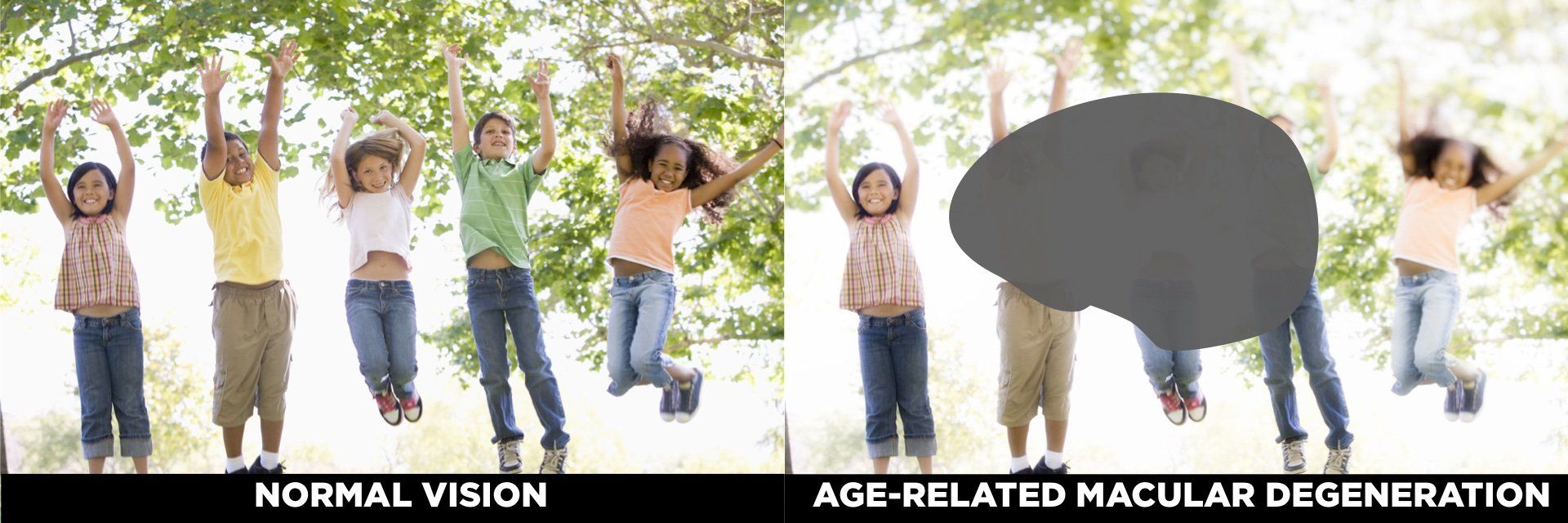Age-related macular degeneration (AMD) is a progressive eye disease and the leading cause of vision loss among people 50 and older.
It causes damage to the macula, a small spot near the center of the retina. The macula is the part of the eye needed for sharp, clear vision of things in front of you. When the macula is damaged, the center of your field of view may appear blurry, distorted, or dark. AMD may develop in one or both eyes.
More than 10 million Americans have macular degeneration, more than cataracts and glaucoma combined. With early detection, treatment can be effective at slowing the progression.
TWO TYPES OF AGE-RELATED MACULAR DEGENERATION
DRY AGE-RELATED MACULAR DEGENERATION
Around 90% of people with macular degeneration have the dry form. It occurs when tiny protein deposits called drusen form under the macula.
Drusen development along with the breakdown of macular pigmentation cause a slow, progressive loss of central vision.
Fortunately, this form of macular degeneration rarely leads to
complete loss of central vision. Very rarely, dry AMD will progress to
wet AMD.
WET AGE-RELATED MACULAR DEGENERATION
This is the more severe form of macular degeneration. It occurs when abnormal blood vessels form under the macula and leak blood and fluid into your retina.
The fluid build up may cause you to see dark spots in your central vision. Wet macular degeneration can quickly lead to central vision loss.
Seek immediate treatment if you have blind spots in your vision, objects appear distorted or you see waves or curves in straight lines.
ARE YOU AT RISK FOR AGE-RELATED MACULAR DEGENERATION?
The following factors are associated with a higher risk of developing AMD:
- Age: Most cases of AMD occur in patients over the age of 60.
- Family History: If your parents or grandparents had AMD, your risk is higher.
- Smoking: Twice the risk of non-smokers.
- UV Exposure: People who work outdoors, under bright fluorescent lighting, or who spend hours on computers
- Nutrition: Poor nutrition increases the risk.
- Eye Color: Blue eyes have a higher risk.
TREATMENT FOR AGE-RELATED MACULAR DEGENERATION
AMD isn't curable but starting treatments early can slow disease progression and keep you from losing too much of your vision. Treatment will depend on the type of disease.
The treatment for dry AMD is generally nutritional therapy. This includes a healthy diet high in antioxidants and nutritional supplements to increase healthy pigments and support the cells of the macula.
The treatments for wet AMD include:
- Anti-angiogenesis medications: These block the creation and leaking of abnormal blood vessels under the macula.
- Laser Therapy: Destroys the abnormal blood vessels in the eye.
- Photodynamic therapy: A combination of an injectable drugs and laser therapy to get rid of extra blood vessels within the eye.
LOWER YOUR RISK OF AGE-RELATED MACULAR DEGENERATION
Steps you can take to lower your risk of AMD:
- Quit smoking
- Avoid junk food - add more leafy veggies to your diet
- Lose weight
- Keep physically active
- Maintain healthy cholesterol levels and blood pressure
- Take nutrition supplements specifically formulated for eye health.
- Get an annual eye exam
Age-related macular degeneration is often symptomless in the early stages. If you are at risk due to age, family history, lifestyle or a combination of these factors, don't wait until you have vision changes before getting screened for AMD. Call Blake Bush Family Eye Care to schedule your eye exam today. 580-223-7333.

